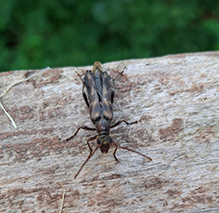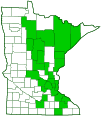ladder-marked longhorn beetle
(Bellamira scalaris)
Conservation • Description • Habitat • Ecology • Distribution • Taxonomy
|
|
||||||||||||||
Description |
Ladder-marked longhorn beetle is a large, distinctive, flower longhorn beetle. It occurs in the United States and southern Canada east of the Great Plains. Adults are found from May through July on various flowers. The larvae are found in decayed wood of both deciduous and coniferous trees. Adults are ⅝″ to 1″ (17 to 26 mm) in length. The body is slender, strongly tapered, and reddish brown. The head is short and broad. It is angled forward in front and is abruptly constricted in back forming a pronounced neck that is visible when viewed from above. The eyes are notched. The antennae are slender and long, at least half as long as the body. The base of each antenna is inserted in the notch in the eye. The pronotum (upper thoracic shield) is about as long as wide. There is a deep impression behind the head and another at the base. The angles at the rear corners of the pronotum are sharply pointed outward. The elytra (hardened wing covers) are long, narrow, and bottle shaped. They are convexly arched on the basal third, then slightly concavely arched to near the tip, making the body appear broad-shouldered. They are dark reddish brown with a variable amount of pale markings. On each elytron, there is a large patch near the base, an oblique patch at the basal quarter, and a narrowly triangular patch on the inner margin at the midpoint. The pattern of the markings is consistent, but the amount and intensity are highly variable. They may be clearly separated or merge together, sharply distinct or diffuse, and boldly contrasting to completely absent. On the male, the tip of the abdomen is expanded. The legs are slender. The color is variable, from mostly light reddish brown with some dark brown on the hind legs to entirely dark brown. The last part of each leg (tarsus), corresponding to the foot, has five segments but the fourth segment is minute and is concealed within the lobes of the heart-shaped third segment, making it appear that there are only four segments. On the hind leg, the tarsi are slender. The first segment is as long as all of the remaining segments together. |
Size |
Total length: ⅝″ to 1″ (17 to 26 mm) |
Similar Species |
Habitat |
|
Ecology |
Season |
|
Behavior |
Adults are active during the day. They are attracted to ultraviolet lights. |
Life Cycle |
|
Larva Food |
|
Adult Food |
|
Distribution |
||
|
Sources |
|
| 7/24/2025 | ||
Occurrence |
||
|
||
Taxonomy |
|
Order |
Coleoptera (Beetles) |
Suborder |
Polyphaga (Water, Rove, Scarab, Long-horned, Leaf, and Snout Beetles) |
Infraorder |
Cucujiformia |
Superfamily |
Chrysomeloidea (leaf beetles and allies) |
Family |
Cerambycidae (longhorn beetles) |
Subfamily |
Lepturinae (flower longhorn beetles) |
Tribe |
Lepturini |
Genus |
Bellamira |
Subordinate Taxa |
|
|
|
Synonyms |
|
Bellamira coarctatus Bellemira scalaris Leptura coarctata Leptura scalaris Strangalia coarctata Strangalia scalaris Toxotus coarctatus |
|
Common Names |
|
ladder-marked longhorn beetle |
|
Glossary
Elytra
The hardened or leathery forewings of beetles used to protect the fragile hindwings, which are used for flying. Singular: elytron.
Pronotum
The exoskeletal plate on the upper side of the first segment of the thorax of an insect.
Visitor Photos |
||
Share your photo of this insect. |
||
This button not working for you? |
||
Luciearl |
||
 |
||
MinnesotaSeasons.com Photos |
||
|
||
|

Slideshows |
|

Visitor Videos |
||
Share your video of this insect. |
||
This button not working for you? |
||
|
Other Videos |
||
|

|
Created: 7/24/2025 Last Updated: © MinnesotaSeasons.com. All rights reserved. |



